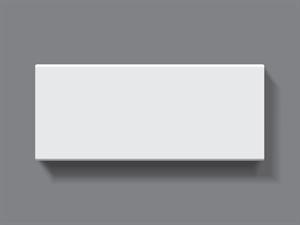
PUMPA - SMART LEARNING
எங்கள் ஆசிரியர்களுடன் 1-ஆன்-1 ஆலோசனை நேரத்தைப் பெறுங்கள். டாப்பர் ஆவதற்கு நாங்கள் பயிற்சி அளிப்போம்
Book Free Demo1. Example of linear equation in one variable:
The perimeter of the rectangular cardboard is \(68 \ cm\). The length of the rectangular cardboard is \(20 \ cm\) more than the breadth. Find the length and breadth of the rectangular cardboard.

Solution:
Let \(x\) be the breadth of the rectangular cardboard.
Let \(20 + x\) be the length of the rectangular cardboard.
Now, let us frame the equation.
Perimeter of the rectangular cardboard \(= 2(l + b)\)
\(68 = 2(20 + x + x)\)
\(68 = 2(2x + 20)\)
\(\frac{68}{2} = 2x + 20\)
\(34 = 2x + 20\)
\(34 - 20 = 2x\)
\(14 = 2x\)
\(\frac{14}{2} = x\)
\(7 = x\)
Breadth \(= x = 7 \ cm\).
Length \(= x + 20 = 27 \ cm\).
Therefore, the length of the rectangular cardboard is \(27 \ cm\), and the breadth of the rectangular cardboard is \(7 \ cm\).
2. Example of linear equation in two variables:
Mary bought \(2\) pens and \(3\) erasers for the cost of \(₹35\). Frame the equation and also find the cost of one pen when the cost of one eraser is \(₹5\).
Solution:
Let \(x\) denote the cost of \(1\) pen.
Let \(y\) denote the cost of \(1\) eraser.
Let us frame the equation.
\(2x + 3y = 35\)
We shall find the cost of \(1\) pen when the cost of \(1\) eraser is \(₹5\).
That is, substituting \(y = 5\) in the above equation, we have:
\(2x + 3(5) = 35\)
\(2x + 15 = 35\)
\(2x = 35 - 15\)
\(2x = 20\)
\(x = \frac{20}{2}\)
\(x = 10\)
Therefore, the cost of \(1\) pen is \(₹10\).
2. The cost of \(5\) chocolates is \(₹15\) times biscuits. The sum of cost of chocolates and biscuits is \(₹40\). Find the cost of a chocolate and a biscuit.
Solution:
Let \(x\) denote the cost of a chocolate.
Let \(y\) denote the cost of the biscuit.
Let us frame the equation.
\(5x = 15y\)
\(x = \frac{15}{5}y\)
\(x = 3y\) ---- (\(1\))
\(x + y = 40\) ---- (\(2\))
Substituting equation (\(1\)) in (\(2\)), we have:
\(3y + y = 40\)
\(4y = 40\)
\(y = \frac{40}{4}\)
\(y = 10\)
Put \(y = 10\) in equation (\(1\)), we have:
\(x = 3 \times 10\)
\(x = 30\)
Thus, the cost of \(1\) chocolate is \(₹30\), and the cost of \(1\) biscuit is \(₹10\).